Where to start? It was a privilege to speak with one of the greatest ultra-endurance riders of our time and to get insight into the immense dedication and sacrifice required to reach the pinnacle of the sport. However, this cycling journey was not as linear as perhaps one would expect, whilst being far more diverse than racing alone. Competitive riding is just one chapter in this epic story, and I was fascinated to hear more about Lael’s early life, extensive international bikepacking/bicycle touring, and how she came to be the professional rider she is today. I was honored to experience Lael’s insatiable passion for cycling firsthand, which is the absolute foundation of her success and immeasurably inspiring. I’ve always said that when I listen to incredible guitarists, like Hendrix, the first thing I want to do is play guitar.

Similarly, after talking with Lael, all you can think about is riding a bike. It’s amazing to see her channel this hypnotic energy into meaningful projects such as Anchorage GRIT (Girls Riding Into Tomorrow), whereby young girls, often from underprivileged backgrounds, get the opportunity to experience adventure riding (more on this below). Lael, you are a legend. Thus, without further ado, I’m very excited to share an interview with pro-ultra-endurance cyclist Lael Wilcox.

Can you tell me a little about your early life?
I was born and raised in Alaska but left at 18 to attend university in Washington State. Interestingly, I didn’t cycle much growing up. I was more interested in soccer and basketball. I rode a bike for fun as a kid but didn’t start riding properly until I went to university. At that time, I was working as a waitress and needed a way to get to work. I’d never owned a car so it was a mode of transport, but after a while, I began to realize the possibilities. I could ride around the city, but also cross-country or even one country to another. It kickstarted a transition from “commuting” to “travel.”I realized I could pack things on my bike, keep riding day-by-day, and see lots of amazing places cheaply. I also enjoyed the physical challenge, the people I got to meet, and the experiences along the way. Things escalated quickly, and I spent the next seven years exploring the world on my bike. I’d work half the year in restaurants and seasonal positions, then spend the other half bicycle touring. I then entered my first cycling race and realized I was good at it, and that changed my approach to riding. I began to split my time between touring and racing, which eventually meant I could ride full-time and compete rather than working side jobs. Additionally, it meant I had time to run programs for women and girls and ultimately base my whole life around cycling, which is super cool.

Why do you love living in Alaska?
The wide-open space and wild animals; it’s pretty raw. If you’re traveling to Alaska, it’s important to allow a decent amount of time to visit because it’s incredibly beautiful but also unpredictable. If the weather’s bad, you could miss out on a lot of scenery. It’s a huge state, and everything’s spread out, e.g., my upcoming time trial is 1,200 kilometers (746 miles; *Lael has since completed this incredible challenge in just 3 days, 18 hours, and 47 minutes), and that’s just to go from North to South Central. There’s a whole other island chain in the southeast, but it’s a 3.5-hour flight to get down there.
You’ve traveled extensively. Is there another place you could call home?
I’m actually planning to buy a house in Tucson, Arizona, this fall. It’s almost the desert version of Anchorage in Alaska, where I grew up. It’s a small city, surrounded by beautiful mountains, the weather’s warm, and it’s sunny throughout the winter. I can ride every day in a T-shirt (unlike Alaska), it’s relatively inexpensive, and close to the Mexican border. It’s become a home base, as I’ve been going there for the past four years. I enjoy spending the winter there, but the summer is too hot for me, so I use the warmer months to travel internationally.
When did your love of cycling begin? Was there a lightbulb moment?
Not really; it took a long time. I was previously a runner and always loved the freedom of being on my feet; the bike was very different. However, you soon realise you can go so much farther, carry more gear, and ultimately have so many experiences on the bike. Eventually, I felt like the bike was part of me, and riding became more like breathing; it became my happy place. That whole process took around eight years of consistent riding—a long time. I’m so glad I took the time to build that relationship with the bike. It’s also much easier on your body; running, particularly ultra-distance, causes a lot of injuries, but with riding, you can recover quickly. It’s amazing that you can ride 200 miles per day and recover in a week. It’s so much smoother and better for your body, particularly as you’re getting older.
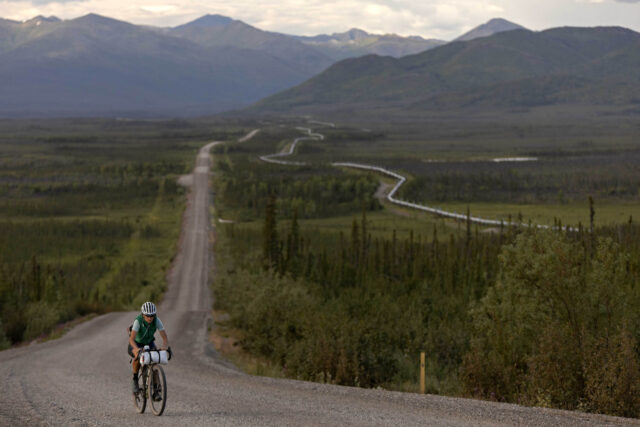
What’s your primary motivation to ride?
It’s about being outside, seeing real places, not knowing what’s around the next corner. I start by wondering what the route will be like, where I could go, and that’s exciting before I’ve even left. As soon as I wake up, I want to get outside and be on my bike; that’s an incredible feeling. It serves so many functions in my life; fitness, fun, transportation, competition, travel. There’s never a reason not to ride; the reasoning just changes depending on the day.
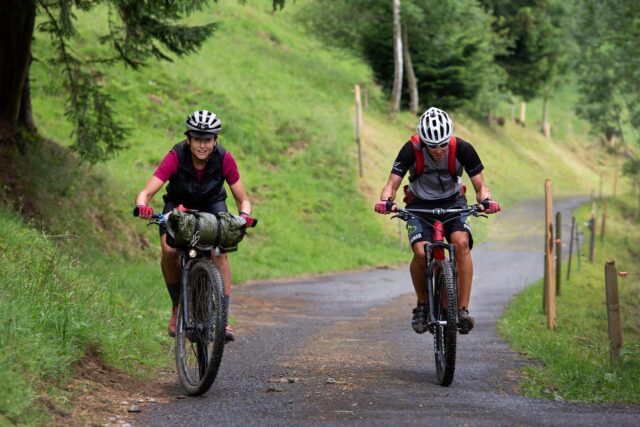
Can you tell me a little about your first ultra-endurance race? What were the lessons you took home from that experience?
My first ultra-endurance race was in 2014 and was supported. It was a 400-mile road race, a qualifier for a race across America. It was in Alaska, and I was up there working in a restaurant. I was borrowing my mum’s road bike on my two days off each week and riding as far as I could. I realized in July that I was in pretty good shape, so entered the race, which had a cut-off time of 32 hours, and you had to have vehicle support (something I’d never experienced). Thus, my friend came along in her jeep, but we had no idea what we were doing. When you’re supported, you rarely need to get off the bike—people should just hand you food and water—so we spent the first three hours figuring out a system. She was throwing candy bars at me, standing at the bottom of hills with water so I could grab it on the go. It was hilarious but also enjoyable. The main thing I learned was that I could complete a race like this; after all, it’s a long way. I completed it in 27 hours, got second place, and the guy who beat me was only 12 minutes ahead. It was hard, but I wasn’t particularly tired, and that taught me that you don’t know what you’re capable of until you give it a go.
At that point, I figured it was something I could do, but I didn’t race until the next spring, this time on a self-supported ride in Israel. I was on a 10-month bikepacking tour around the world, starting in Eastern Europe, then South Africa, continuing with the Middle East. I entered the race because I was already touring the route. It was the Holy Land Challenge, which is super cool, and I wondered what it’d be like to race it. The route was around 1,400 kilometers (870 miles), mostly single track/dirt roads, and I had my touring set up, but I figured I could do it. I was the only woman in the race, and by the end of the day I was leading by 40 kilometers. The guys were like, “How’s she doing this?” I was staying on my bike, riding hard, and sleeping for just three hours. In honesty, it was so exciting and such an incredible country. During the race, you’re riding through the desert, mountains, and then the old city of Jerusalem; it was amazing to be there. It’s not just about fitness; it’s how you make the best of the time on the bike, multi-task, and deal with whatever comes up. It’s self-supported, so if you have a mechanical issue, you have to fix it; you need to find food and water, a place to rest, calculate how much to sleep. There are so many elements that play into the overall experience, and that’s all part of the fun.
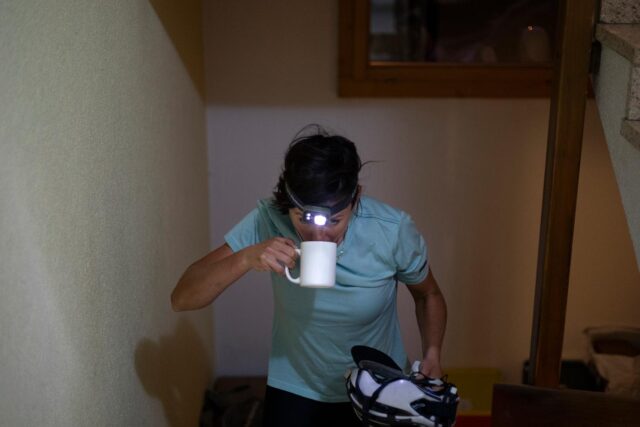
How do you prepare for a ride like the Tour Divide?
Both times, I rode to the start line from Alaska, so that was my training. It meant I had an adventure at my own pace and could enjoy the landscapes en route to the start. I do some training off the bike: planks, push-ups, a back workout, etc., but these are just things to keep my core strong and prevent injuries. I used to jump rope for my Achilles [heel]. I still run, but everything is focused on ensuring I can keep riding. There’s not a huge toll on the body when you ride, but it’s very one-directional, so you need to do a bit more side-to-side to remain healthy.
Can you recount your crazy Tour Divide story?
I rode to the start line, 2,100 miles (3,380 kilometrers), from Anchorage to Banff, took a week off, then started the race. Unfortunately, within the first day, I had some pretty serious breathing problems; it was debilitating. I’d wake up in the morning, and throughout the day, it would get worse, and in the end, it felt like I was breathing through a straw. This went on for five to six days, and I eventually rode myself to the emergency room in Montana. They X-rayed my lungs to check [for] pneumonia, then asked when my race started, and I said, it’s still going. They said I had lungs as cloudy as a 70-year-old, gave me some medication/inhaler, and I got back out there. I struggled for a few more days but gradually picked up the pace and broke the women’s record by two days. However, afterward, I was frustrated because I knew if I hadn’t been sick, I could’ve ridden so much faster. Those thoughts stuck with me until I just had to do it again.
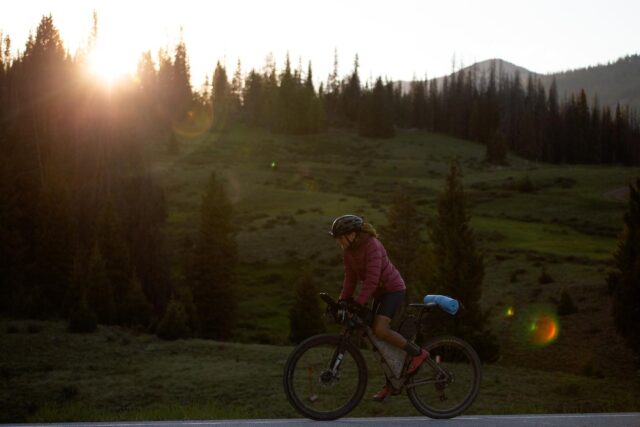
So, within two weeks, I returned to Alaska and rode back to the start-line, but I took a different route to keep it interesting. I then rode the race again, but as a time trial, and took another day and a half off my original time. Even on that run, I got stuck in mud for 12 hours. That’s the thing with the Tour Divide, it’s so hard to get a clean run. Rain, mud, forest fires, you can’t control everything. That’s actually why I raced the Trans-America Race, because it’s all paved, and I couldn’t be stopped by the weather, and that’s what I did the following year. The race is much longer, approximately 7,000 kilometrers (4,350 miles), West to East across the US. It’s hard; it never feels like it’s going to end. I’m glad I raced it, but I’d never do it again. But I did win, catching the guy on the final night—it was really exciting. I caught up by cutting rest, which meant six hours of sleep in three days, and I was out of my mind. You have to make up time somewhere, and sleep is something you can cut, but it is pretty awful. The next year I cycled all the roads in Alaska, the following summer rode the Hope 1000 in Switzerland, that August I raced the French Divide, then the next year I cycled the Tour Divide again and the Silk Road Mountain Race in Kyrgyzstan.
Is there any particular ride that stands out as the most challenging?
They’re all so different. The Switzerland route is challenging because of the climbing, 30,000 meters (98,425 feet) over 1,000 kilometers (621 miles), which is hard going on a loaded mountain bike over tough terrain. On the flip-side, it’s in Switzerland, so there’s food and water everywhere, which makes it easy to get supplies. The race in Kyrgyzstan was super tough because it snowed for half the day and it was also challenging to find food and resources. They all have their hurdles. If I had to pick one, it would be a time trial I completed on the Arizona trail; it’s so technical, on rough singletrack—a physical beating. A lot of the route isn’t rideable, so you’re constantly on and off the bike. At one point, you have to carry the bike on your back for 40 kilometers (25 miles) through the Grand Canyon. That was brutal!

I’ve enjoyed your short films on YouTube, with the likes of Chris Burkard. Are you able to remove your racing mindset during recreational trips? Do you enjoy the slower pace sometimes?
Carrying the bike on that ride was so physically demanding. The guys could casually stand around with the bike on them, but I simply don’t have the frame to do that. I had to walk super fast, get ahead, then take time to rest. It wasn’t competitive—just a case of getting it done. When you’re riding with friends, you want to take time to be social. I don’t always want to ride quickly, but you have times on the ride where it’s fun. On that ride, Chris was great as he’s super fit and loves riding fast.
How do you manage the lows during ultra-endurance riding?
There are lots of highs and lows, and the lows are a challenge. But because I’ve done so many races, I know that the hard moments won’t last forever. I’ll accept that the next hour or so will be rough but that it will pass. I check in with myself; ultimately, if I’m giving it my all then, that’s all I can do, and it’s important to remind yourself of that. Sometimes I’ll listen to music or an audiobook, eat a snack—little things to uplift my mood and make the best of it. I work hard to avoid negativity, as that doesn’t help anything. Once you get through those dark hours, there’s always something beautiful that comes up, and I’m quickly reminded how lucky I am to have these experiences.
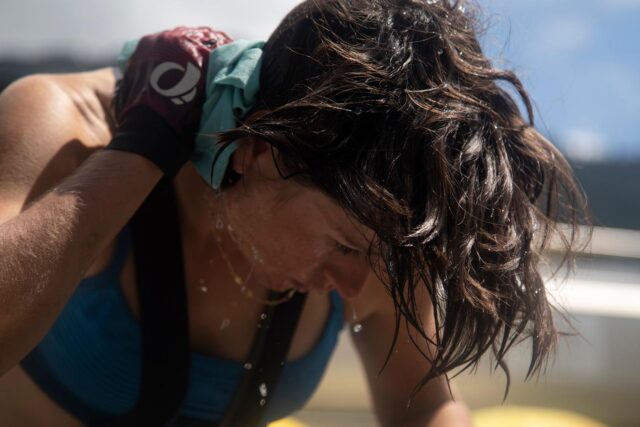
Favorite bike/bikes, and why?
My specialty is climbing dirt roads. I’m not a technical mountain biker, but I still enjoy it because I learn a lot, and it takes you to cool places. However, I’m in my element climbing dirt roads, like the Divide or the Hope 1000. Whenever you climb, you’re often rewarded with beautiful views. I’ve got nerve damage in my hands from so much riding, and I find drop bars are more comfortable because of that. Having hands parallel, instead of flat, is more comfortable, so where possible, I’ll utilize a drop-bar bike. But if it’s super steep or technical, I’ll switch to flat bars.

I’ve been working with Specialized since 2015, and I love the bikes they make. It’s funny because a lot of their models are made for one-hour road races and not intended for ultra-endurance, but I modify the bikes for purpose. Consequently, I get to ride these super-light/fast road bikes, but comfortably for 20 hours a day. So, I’ll take their hardtail and fit a drop bar, which makes it look kind of funky, but I can run a 55-millimetre tire perfect for rough dirt roads. I currently have their Epic Hardtail. I just want the bikes to work, but that’s asking a lot on these big rides. Even if they’re in great shape at the start, by halfway, they’re so beat up. It’s great to see how they stand up to the punishment.
What are some of your favorite bikepacking bags?
Revelate Designs were my first sponsor, and I’ve been riding with their gear since 2012. Since then, they’ve constantly innovated and continued to make products I love. They’re also from Alaska, which is super cool, and they’ve influenced bikepacking so much. They were one of the first companies to make bags widely available for bikepacking, which is amazing. Their new Spinelock Seat Packs are waterproof and don’t sway at all, which is awesome. And, their front handlebar options are lightweight and sophisticated. Revelate is really all I’ve used since 2012, but when I first started touring, I had a simple rack and pannier setup. I think this approach still works great for people riding on paved/dirt roads—just nothing too rough. It’s also particularly effective for smaller riders who don’t have a frame big enough for a full-size frame bag and can’t fit a seat pack because they don’t have enough seat post exposed. I recommend keeping it minimal, as bikes ride so much better when they’re not loaded heavy.
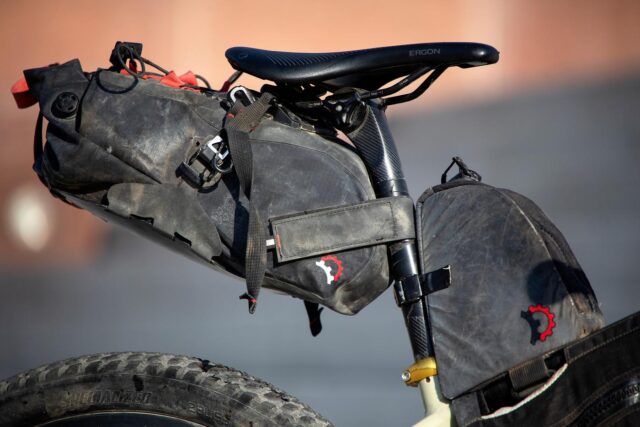
Does your bikepacking bag setup for ultra-endurance rides differ from recreational touring?
It’s basically the same format, but I try to lighten it. I don’t bring a tent racing, which I almost always pack touring. On the Hope 1000 in Switzerland, I had a dropper post, and that’s tricky with a seat pack, so I just had a frame bag and a little front roll. Technical mountain biking is definitely the hardest for packing because suspension gets in the way, or a dropper post limits you. Consequently, you have to be creative or compromise on equipment.
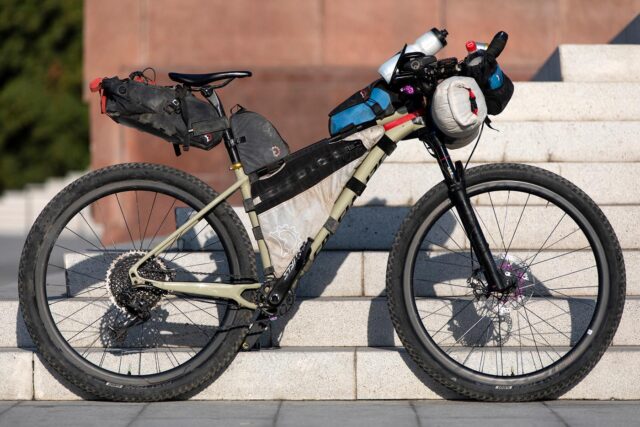
What are your bikepacking essentials?
Most of the time, I have a down jacket, even if it’s not particularly cold. If I’m riding hard and sleep-deprived, I often struggle to get warm. I generally run at a colder temperature, and if you get cold, you lose all your energy. There’s nothing else particularly notable, but I’ll prioritize certain things depending on the race. In Switzerland, I decided to go for flat pedals and running shoes because I knew I’d be on and off the bike so much. Essentials thus differ depending on the ride objectives.
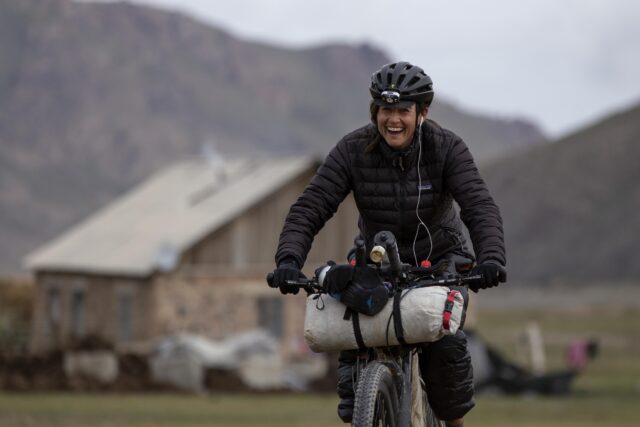
Food for fuel?
Milk/chocolate milk and ice cream are some of my favorites. I’ve started working with a nutrition company called Gnarly Sports Nutrition and experimenting with vegan protein shakes to help recovery (these worked well in Switzerland). I try to eat lots of real food: pizza, sandwiches, French fries, baked goods. Some places are harder than others. In Kyrgyzstan, I just ate fried bread. I think people fantasize about eating lots of junk food on something like this, but it’s amazing how quickly you get tired of it!
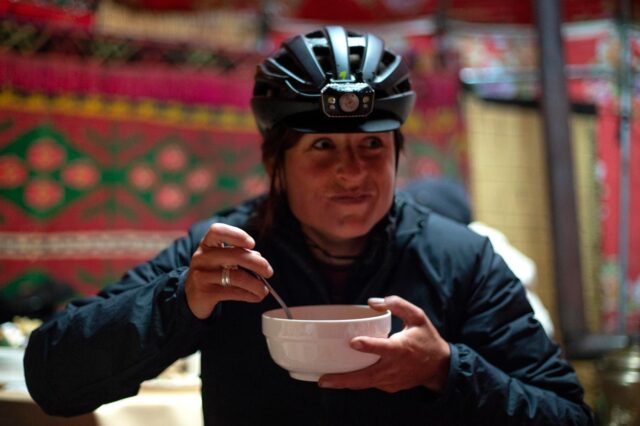
Can you tell us about Anchorage GRIT?
Anchorage GRIT is a program for 12- to 13-year-old girls; I’ve done three seasons of it. It’s aimed at girls who don’t get a lot of opportunities, low-income households from East Anchorage, where I grew up. We ride together for six weeks, and before the program, they’d never ridden more than five miles. At the end of the program, they complete a 60-mile, three-day adventure ride from their school into the wilderness, carrying what they need. Specialized has provided bikes, and upon completion, they get to keep them, which is awesome as it finishes just before summer break. The following year they can return as student mentors, which is also really nice. I started the program with a friend as it’s something I’d have loved to do growing up. I didn’t know about bike touring, and I often think how cool this opportunity would’ve been as a 12-year-old riding with friends. I’m planning on starting another one in Arizona when I move there this fall. Arizona is quite a poor state, so I’d love to provide this opportunity to girls living there. It’s so cool watching them grow in confidence over such a short time; kids improve so quickly.
If you could visit your past in a time machine, what words of wisdom would you offer teenage Lael?
I’d tell myself not to be so hard on myself. Growing up, I was super serious and competitive. I worked hard in school, but I never felt like I was doing enough, even though I was doing great. These days I know I’m trying my best, and that’s all you can do. If you’re trying your hardest, you should always feel good about that.
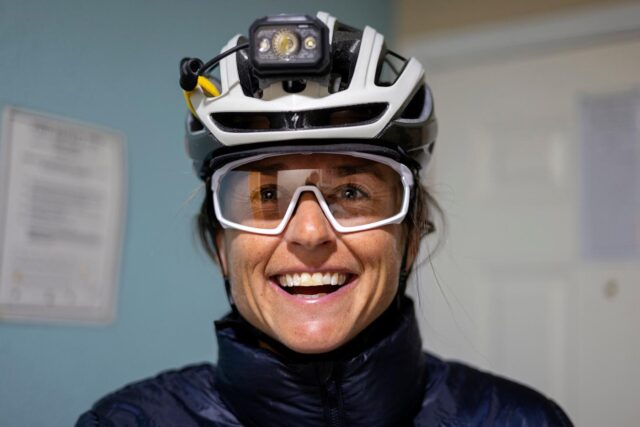
Where can we find you?
Websites:
laelwilcox.com
anchoragegrit.com
specialized.com
revelatedesigns.com
Instagram:
@laelwilcox
@anchorage_grit
Special thanks to Rugile Kaladyte for providing the photography featured in this interview.
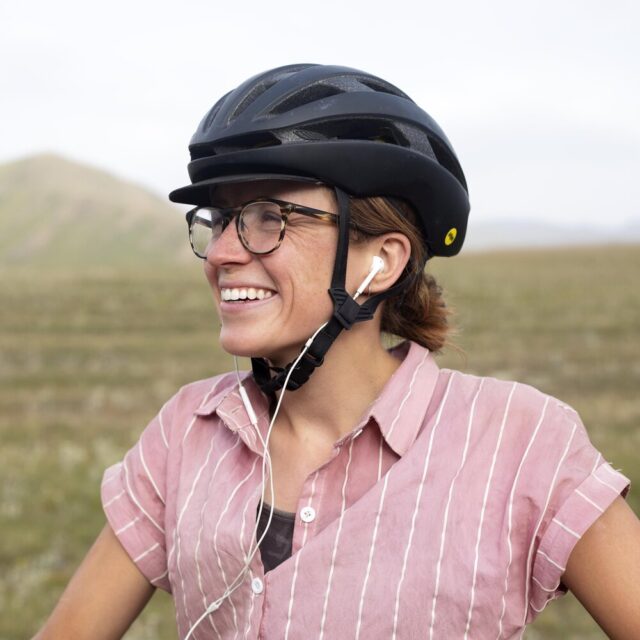
Our No Compromise Clause: We carefully screen all contributors to make sure they are independent and impartial. We never have and never will accept advertorial, and we do not allow advertising to influence our product or destination reviews.


